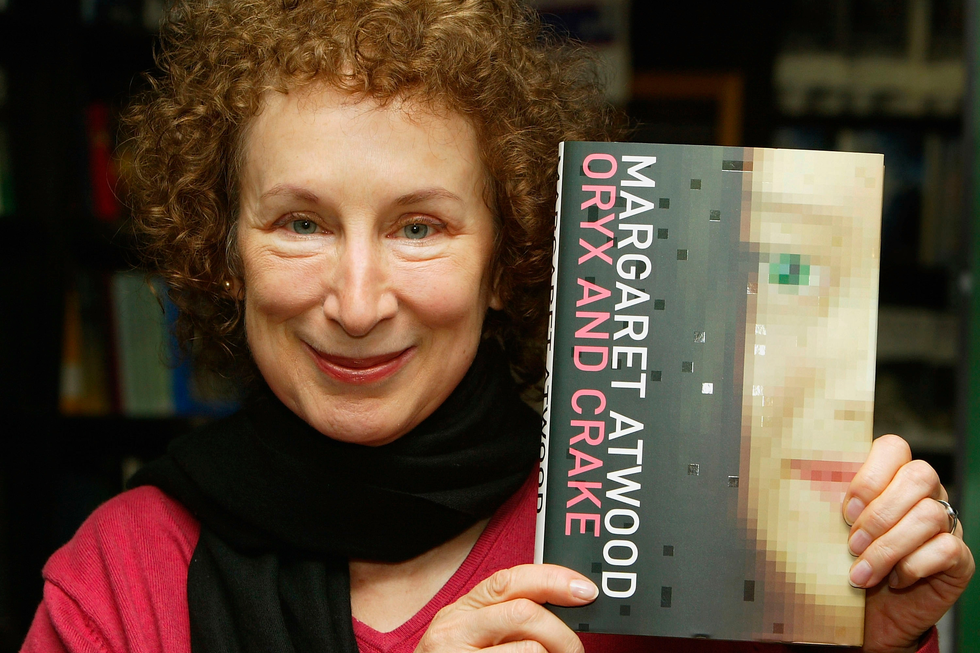Breanna Robinson
May 13, 2022
Pro-choice protestors in Handmaids' Tale costumes surround Justice's house
Video
Canadian poet and novelist Margaret Atwood has been hailed a prophet for her speculative works of fiction detailing dystopian futures - and even though she resists the label, some of it has come true.
In a 2017 interview withSlate, Atwood said that she doesn’t predict the future so much and that her stories “are actually about the now.”
“However, it’s also true that you generally look ahead of you to see where you’re going, and that’s what those kinds of books are like. They’re like blueprints of the possible futures that help us to decide whether that is where we want to go,” she told the outlet.
Atwood seems to not only want to wake up the masses; she wants to prevent us from walking a path that could lead to isolation, disaster and overall anguish.
Specifically, she's taken us through the dystopian lens of threats posed by sex robots, bioengineering and authoritarianism.
With that said, here are some of the instances in Atwood’s body of work that gave uncanny predictions of the future.
Sign up to our new free Indy100 weekly newsletter
The Handmaid’s Tale and authoritarianism
When former President Donald Trump entered the White House, nearly 20 years after The Handmaid’s Tale was published, the book reappeared on the bestsellers list - and it wasn’t a coincidence.
The story was set in the near-future Republic of Gilead, a theocratic authoritarian regime located in what was once the US.
Many fans drew comparisons between the fictional government’s fascism and the treatment of women amid the rise of Trumpian America.
Although American women weren’t being forced into sexual surrogacy like Atwood’s handmaids, fear and the sense of a regressive shift loomed.
This year, protesters across the country and abroad were spotted holding signs such as “Repro rights are human rights” and “Keep abortions safe and legal” at abortion rights demonstrations following news of the potential overthrow of Roe v Wade.
Women go into a church dressed as charecters from "The Handmaid's Tale" as a protest over Roe v Wade.pic.twitter.com/ZaV3J5lCYt— \ud83d\udc51Nullen, Shitcrumblin Twatsicle, Biscuit Overlord (@\ud83d\udc51Nullen, Shitcrumblin Twatsicle, Biscuit Overlord) 1652098880
Atwood’s decision to only incorporate events in the book that occurred in history such as book burnings; mass executions; state-supported birthing; and kidnapping programs, warn us that what has happened before can happen again.

“The Handmaid’s Tale was about trends that were already there in the now event, and what might happen if those trends continued on in that way,” Atwood told Slate.
The Bioengineering of humans and animals in Oryx and Crake
Atwood also strikingly foresaw the development of bioengineered pigs with frightening accuracy in her 2003 novel Oryx and Crake.
As part of her MaddAddam trilogy, this fiction speaks about how human-pig chimeras called "pigoons" are genetically engineered to grow human organs for transplants.
And in 2016, Pablo Ross, a biologist at the University of California, Davis, brought his very real project to the forefront. It was developed hybrid human-pig embryos by inserting human stem cells inside pig embryos.
Just like the scientists in Oryx and Crake, he sought to tackle the global shortage of organs needed for transplants by growing functional human ones inside of pigs.

Ross has successfully gotten one of his animals to grow a human pancreas.
However, unlike in the MaddAddam trilogy, we aren't in a post-apocalyptic world that has highly intelligent and murderous pigs created in a well-intentioned environment by scientists in an experiment gone terribly wrong.
But, a dystopian future in which pigs develop human brains doesn't seem farfetched.
"We think there is very low potential for a human brain to grow, but this is something we will be investigating," Ross said in conversation with BBC.
This little piggy grew a human pancreasyoutu.be
The Heart Goes Last and sex robots
The Heart Goes Last, which was written in 2015, portrays a near-future stricken with poverty, yet it flourishes with technological advancements that include realistic humanoid robots called "prostibots" that can be in likeness to celebrities.
The world as we know it hasn't created those rather convincing android lovers.
Regardless, Atwood's focus on high-level robotics being in sex work and the moral obstacles are dilemmas are relevant today.
For example, in April 2018, the first robotic sex doll head went on sale. It was created by Abyss Creations, a known silicone love doll company, with the aid of top roboticists.
The full robotic version of the body also happens to be in development.
Atwood also accurately foreshadowed the controversial arguments on the topic, such as whether or not it is appropriate to make sexbot replicas of living people without permission or ones that resemble underage children.
Elsewhere, she expresses her concerns about the future, with the hopes to help us understand and prevent the potentially harmful outcomes by printing them.
The inaugural Santa Fe Literary Festival will be taking place between 20-23 May 2022. The four-day event is set to explore issues at a time of extraordinary change – in politics, race, immigration, the environment, and more. Our sister title, The Independent, is the event’s international media partner and will be providing coverage across each day of the festival as well as during the lead up with exclusive interviews with some of the headline authors. For more on the festival visit The Independent's Santa Fe Literary Festival section or visit the festival’s website here. To find out more about buying tickets click here.
Top 100
The Conversation (0)














